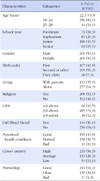Abstract
Purpose
The study was done to examine undergraduate student' suicidal ideation and to identify influences of individual characteristics including psychological resilience and self-control on suicidal ideation.
Methods
Data were collected from 400 students in 11 universities in D city from May 1 to June 30, 2011. Data were analyzed with t-test, one-way ANOVA and Pearson' correlation using SPSS 19.0.
Results
Of the students, 11.3% reported suicidal ideation levels higher than average. Woman students and those with high career anxiety, perceived poor health condition and bad relationships showed higher points on suicidal ideation. Suicidal ideation was also negatively correlated with psychological resilience and self-control.
Conclusion
Over 10.0% of students need careful attention on suicidal ideation, especially counselling service related to suicide prevention for students with poor health, high career anxiety, and bad relationships. Various programs should be developed to promote psychological resilience to improve health and relationships, as well as job guidance for students. It is also suggested the students' experiences be examined to determine how they overcame suicidal ideation.
Figures and Tables
References
1. Korean Statistical Information Service [KOSIS]. Cause of death statistics, 2012 [Internet]. Seoul: Korean Statistical Information Service;2013. cited 2013 September 10. Available from: http://kostat.go.kr/portal/korea/kor_nw/3/index.board?bmode=read&aSeq=308560.
2. OECD. "Suicide", in Health at a Glance 2013: OECD Indicators [Internet]. Paris: OECD;2013. cited 2013 November 21. Available from: http://dx.doi.org/10.1787/health_glance-2013-10-en.
3. Pyeon DW. Why is this KAIST increased suicide? Enewstoday. 2014. 10. 17. sect 09. http://www.enewstoday.co.kr/news/articleView.html?idxno=347729.
4. Jung JW. Students live in a country populated by college students commit suicide. Kyung-Hyang Sinmun. 2011. 09. 28. sect 09. http://news.khan.co.kr/kh_news/khan_art_view.html?artid=201109280944112.
5. Park E. The influencing factors on suicide attempt among adolescents in South Korea. J Korean Acad Nurs. 2008; 38(3):465–473.

6. Reinherz HZ, Tanner J, Berger S, Beardslee W, Fitzmaurice G. Adolescent suicidal ideation as predictive of psychopathology, suicidal behavior, and compromised functioning at age 30. Am J Psychiatry. 2006; 163(7):1226–1232.

7. Park E, Choi SJ. Prevalence of suicidal ideation and related risk factors among Korean adults. J Korean Acad Psychiatr Ment Health Nurs. 2013; 22(2):88–96. http://dx.doi.org/10.12934/jkpmhn.2013.22.2.88.

8. Baek SS, Ha EH, Ryo EN, Song MS. Effects of life stress and depression in undergraduates on suicidal ideation. J Korean Acad Child Health Nurs. 2012; 18(4):157–163. http://dx.doi.org/10.4094/jkachn.2012.18.4.157.

9. Kang SW, Ra DS. A study on the mediating effects of depression between senior student' university life stress and suicidal ideation. Korean J Youth Stud. 2013; 20(4):49–71.
10. Hong YS. The effects of life stress and self-esteem for adolescent suicidal behaviors. Korean J Youth Stud. 2004; 40:153–182.
11. Kim JB. Effects of student-teacher relationship on students' psychological resilience. Korean J Educ Psychol. 2012; 26(2):523–541.
12. Kim DH. The mediating effect of resilience between adult attachment and depression. [master's thesis]. [Daegu]: Kyungpook National University;2010. 80.
13. Kanfer FH, Goldfoot DA. Self-control and tolerance of noxious stimulation. Psychol Rep. 1966; 18:79–85.

14. Ha JH, An SH. The verification of a structural relationship model of suicidal ideation to stress, coping styles, perfectionism, depression, and impulsivity. Korean J Couns Psychother. 2008; 20(4):1149–1171.
15. Reynolds WM. Suicidal ideation questionnaire (SIQ). Odessa, FL: Psychological Assessment Resources, PO Box, 998;1987.
16. Hong YS, Joen SY. The effects of life and depression for adolescent suicidal ideation. Ment Health Soc Work. 2005; 19(4):125–149.
17. Atsushi O, Hitoshi N, Shinji N, Motoyuki K. Development and validation of an adolescent resilience scale. Jp J Couns Sci. 2002; 35:57–65.
18. Jung EO. A Validation of psychological resilience scale. [master's thesis]. [Joenju]: Chonbuk National University;2006. 40.
19. Grasmick HG, Hagan J, Blackwell BS, Arnerklev BJ. Testing the core empirical implocations of Gottfredson and Hirschi's general theory of crime. J Res Crime Delinq. 1993; 30:5–29. http://dx.doi.org/10.1177/0022427893030001002.

20. Ha CS, Kim BS. A exploratory factor analysis of Korean version of the self-control scale. Korean J Couns. 2005; 6(4):1175–1188.
21. Choi MS. A study of the suicide on campus. Underst People. 2007; 28(1):49.
22. Crosby AE, Gfroerer J, Han B, Ortega L, Parks SE. US Department of Health and Human Services, Centers for Disease Control and Prevention. Suicidal thoughts and behaviors among adults aged ≥18 years-United States, 2008-2009. MMWR Surveill Summ. 2011; 60(13):1–22.
23. Yang KM, Bang SY, Kim S. Factors influencing suicidal ideation in university students. Korean J Stress Res. 2012; 20(1):41–50.
24. Lee JK, Choi ME. A study on the influence of suicide coverage and psychological variables on college students' intention for suicide: with a focus on suicide coverage of public figures and college students, stress, impulsivity, self-esteem, and theory of planned behaviors. Broadcast Commun. 2011; 12(4):147–187.
25. Lee EK, Park JA. Ego-resilience and the clinical competence of nursing students. J Korea Community Health Nurs Acad Soc. 2013; 27(2):293–303. http://dx.doi.org/10.5932/JKPHN.2013.27.2.293.

26. Hong ES. Conceptual understanding of resilience and instructional suggestion. Korean J Spec Educ. 2006; 41(2):45–67.
28. Parse RR.
OJ Lee
JS Lee
MS Go
CH No
. The human becoming school of thought. 2nd ed. Seoul: Hyunmoonsa;c2002. p. 170.
29. Kim JJ. An analysis of variables related to university student's suicidal ideation-regarding effect of suicidal attempt experience, mental health, psychosocial problems. Ment Health Soc Work. 2009; 32:413–437.




 PDF
PDF ePub
ePub Citation
Citation Print
Print







 XML Download
XML Download